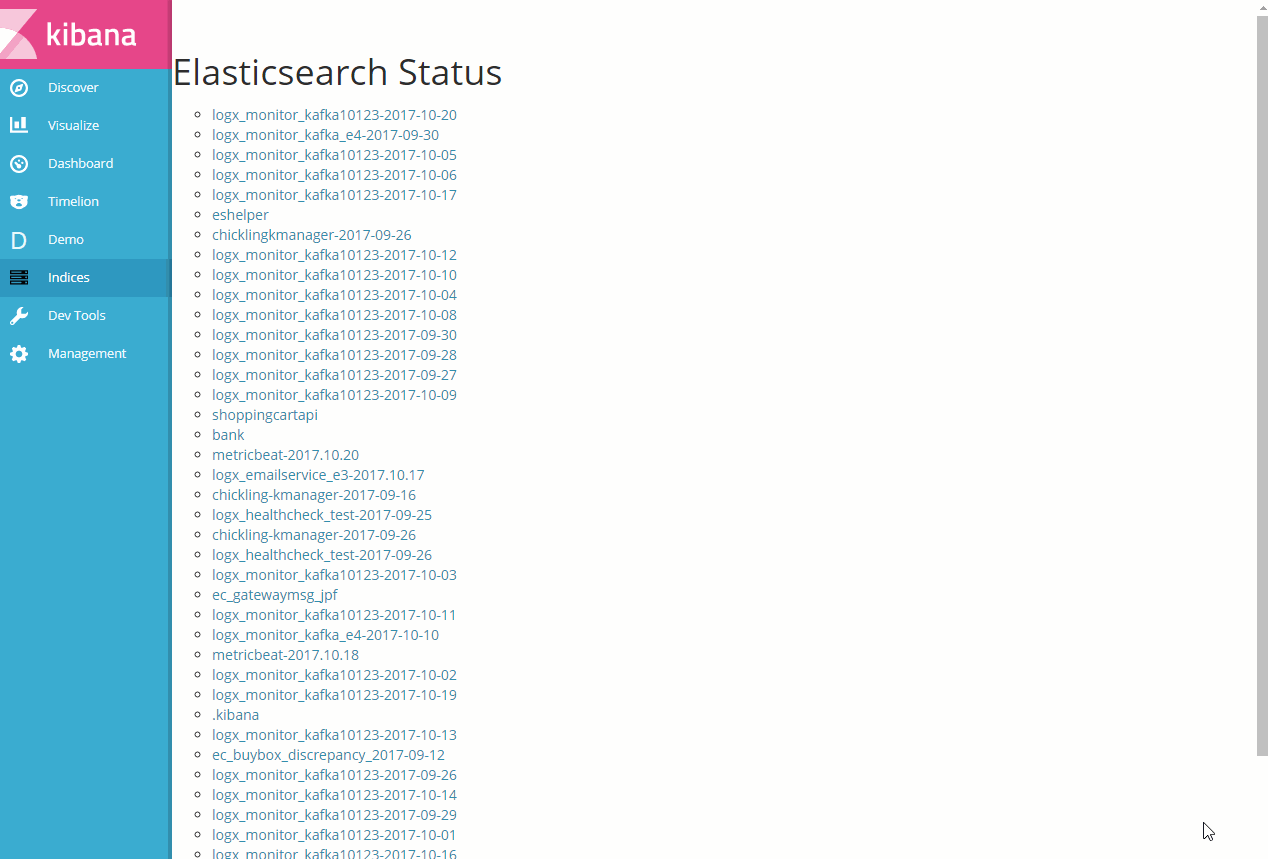app案例之elasticsearch_status
优质
小牛编辑
136浏览
2023-12-01
简介
在这个案例中,项目目标是实现一个elasticsearch_status
app插件,在插件中可以查看elasticsearch 所有的index,以及他们的status。在这个案例中主要讲解如何开发app插件,以及如何在kibana中与elasticsearch通信。
实践
准备
首先新建项目 elasticsearch_status(源码详见)
然后利用模板工具生成项目
1.修改index.js
这个文件主要是根据kibana api 定义该插件类型,本次demo 定义插件类型为app.修改内容如下:
const api =require('./server/routes');
export default function (kibana) {
return new kibana.Plugin({
require: ['elasticsearch'],
uiExports: {
// Register the app component of our plugin to uiExports
app: {
// The title of the app (will be shown to the user)
title: 'Indices',
// An description of the application.
description: 'An awesome Kibana plugin',
// The require reference to the JavaScript file for this app
main: 'plugins/elasticsearch_status/app',
// The require reference to the icon of the app
icon: 'plugins/elasticsearch_status/icon.svg'
}
},
// The init method will be executed when the Kibana server starts and loads
// this plugin. It is used to set up everything that you need.
init(server, options) {
// Just call the api module that we imported above (the server/routes.js file)
// and pass the server to it, so it can register several API interfaces at the server.
api(server);
}
});
};在上面代码中app{}按照kibana插件接口编写,没有什么好解释的。在init(){}方法可以在kibana启动的时候调用,在这里面可以做任意化的操作,这块是用作server端,提供路由查询elasticsearch功能。该方法中传入参数server,也很有用途,比较获取配置信息,创建路由等。
2.新增routes.js
在server目录新建routes.js文件,主要是用作提供server端查询elasticsearch数据。
export default function (server) {
const call = server.plugins.elasticsearch.getCluster('admin').callWithRequest;
server.route({
path: '/api/elasticsearch_status/indices',
method: 'GET',
handler(req, reply) {
call(req, 'cluster.state').then(function (response) {
// Return just the names of all indices to the client.
reply(
Object.keys(response.metadata.indices)
);
});
}
});
// Add a route to retrieve the status of an index by its name
server.route({
path: '/api/elasticsearch_status/index/{name}',
method: 'GET',
handler(req, reply) {
call(req, 'cluster.state', {
metric: 'metadata',
index: req.params.name
}).then(function (response) {
reply(response.metadata.indices[req.params.name]);
});
}
});
};3.新增app.js
const uiModules =require ('ui/modules');
const uiRoutes =require ('ui/routes');
require ('ui/autoload/styles');
require ('./less/main.less');
const overviewTemplate =require('./templates/index.html');
const detailTemplate =require('./templates/detail.html');
uiRoutes.enable();
uiRoutes
.when('/', {
template: overviewTemplate,
controller: 'elasticsearchStatusController',
controllerAs: 'ctrl'
})
.when('/index/:name', {
template: detailTemplate,
controller: 'elasticsearchDetailController',
controllerAs: 'ctrl'
});
uiModules
.get('app/elasticsearch_status')
.controller('elasticsearchStatusController', function ($http) {
$http.get('../api/elasticsearch_status/indices').then((response) => {
this.indices = response.data;
});
})
.controller('elasticsearchDetailController', function($routeParams, $http) {
this.index = $routeParams.name;
$http.get(`../api/elasticsearch_status/index/${this.index}`).then((response) => {
this.status = response.data;
});
});该文件主要是提供controller,调用后台API,在页面展示数据
index.html
<div class="container">
<div class="row">
<div class="col-12-sm">
<h1>Elasticsearch Status</h1>
<ul class="indexList">
<li ng-repeat="index in ctrl.indices">
<a href="#/index/{{index}}">{{ index }}</a>
</li>
</ul>
</div>
</div>
</div>显示所有index 列表
detail.html
<div class="container">
<div class="row">
<div class="col-12-sm">
<a href="#/">Index list</a>
<h1>Index: {{ ctrl.index }}</h1>
<pre>{{ ctrl.status | json }}</pre>
</div>
</div>
</div>4.运行
在kibana 根目录下执行 npm start命令即可,效果如下:

